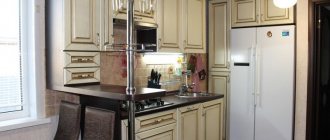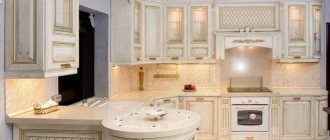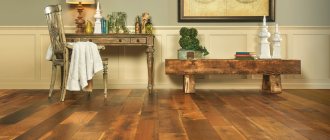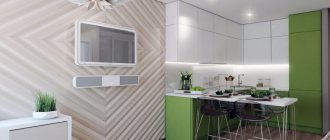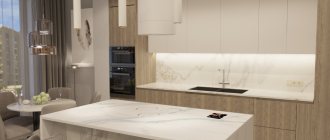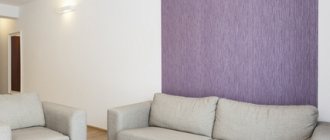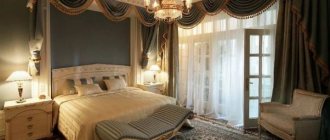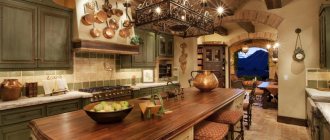Antiques and vintage are terms that have firmly entered the vocabulary of lovers of stylish and colorful antiquities. Things designated by these words are distinguished not only by their “age”, but also by their unique, special luster. Many people want their home to be furnished not only with functional and practical, but also with stylized furniture. However, not everyone can afford expensive antique items. In this case, the aging technique comes to the rescue. Patina is used to create it.
The appearance of headsets with this element is truly unique.
What types of patinas are there for the kitchen?
Patina is a kind of greenish coating that appears on copper products after some time. Its formation is caused by exposure to air and moisture. The peculiarity of patina is that over time, more and more layers of it grow. Thanks to this, the objects acquire the effect of mystery and “museum-like”.
Patina is a special type of decorative coating on furniture that helps to visually age the furniture without losing its aesthetic component.
The kitchen, like any other room in the house, can be furnished not only with comfort, but also with unique charm. Fortunately, modern options for decorating techniques allow you to choose the most suitable one. For those who like to surprise and amaze their acquaintances, and who also emphasize respectability, patinated facades of kitchen furniture are perfect.
Types of patina depending on composition
- Bituminous.
Bituminous varnish is applied to a specific surface. It gets into the recesses and stays there, making them darker than the base.
- Acrylic.
Acrylic paint is mixed with a medium and applied to the surface. Thanks to the variety of colors, this patina can be used to create different design solutions.
Kitchens with patina look very noble and often even more comfortable than some options without it.
- Chemical.
It is applied to a metal base. Oxidant and water paint create a natural aging effect in a few hours.
- Shellac.
With its help, surfaces acquire a light yellow to red-orange hue.
- Wax.
This type is great for textured and cracked surfaces and unprimed wood.
On sets with patina any dirt is much less noticeable.
Types of patina depending on the effect created:
- Gold and silver.
This coating looks especially impressive on white, black and light wood (for example, oak) surfaces. A matte varnish is best suited for coating. With its help, the set will acquire a more gentle and calm look.
Such finishing, as a rule, is carried out at the final stage of decorating the fittings.
- Contrasting (silver, gold, copper, bronze).
This patina looks most impressive on relief facades. It will favorably emphasize every curve of the pattern. It should be thoroughly rubbed into the lower parts of the relief, and then applied to the entire embossing.
To create the effect of antiquity, the facade is rubbed using elements such as sponges of varying hardness, washcloths or even scrapers.
- With the effect of craquelure, crackle.
This coating is used together with a contrasting patina, which is applied to the craquelure varnish after drying. It penetrates perfectly into the cracks that have formed and creates the effect of old paint.
A mandatory procedure is the subsequent application of varnish, which helps to fix the result.
How the process of patoning facades in the kitchen is carried out
The advantages of a process such as patonation are that it can be applied to almost any surface, even to such a simple material as MDF. Before you start work, you need to prepare all the tools and materials. These include: spray bottle, brushes, colorless polyurethane primer, varnish.
To begin with, an insulator is applied to the surface to be treated, that is, to the façade. The soil should be applied evenly, in a very thin layer - a spray bottle can achieve this effect. After this, colorless polyurethane primer is applied to the surface of the facade in the same thin layer. After drying, it must be thoroughly sanded, then the patina itself must be applied. After this, the facades are wiped with a hard or soft sponge (depending on what effect should be achieved).
The more intensive such grinding is, the more aged and textured the facade will look. As soon as this stage of work is completed, glossy or matte varnish should be applied to the surface to be treated in several layers.
Tip: To protect kitchen furniture from moisture and steam, you should use polyurethane varnish.
Advantages and disadvantages of patination
Like any other process, aging has several positive and negative qualities. Let's look at the main ones.
Advantages
- Increased wear resistance.
The use of a composition that is used to patina the varnish creates an additional and durable protective layer. It allows you to make the furniture façade resistant to moisture, steam and frequent cleaning.
- Long service life.
Even after many years of use, products covered with patina do not lose their original appearance.
Patina can be created in a variety of colors, each of which adds a special flair to the kitchen fittings.
- Functionality and practicality.
Furniture that lends itself to the aging process only appears fragile and dilapidated. In fact, she does not need special care. In addition, patina also allows you to hide minor cracks and irregularities.
- Effectiveness and originality.
A kitchen made in vintage style will not leave even the most demanding housewives indifferent. She will become truly extraordinary and stylish.
This solution is optimal for kitchen furniture with a complex type of milling.
- Low cost.
Unlike real antique furniture, a kitchen set with a patina of different colors is not so expensive. But at the same time, it is not inferior in its external characteristics.
Flaws
- Fire hazard.
Products covered with patina are highly flammable. Therefore, they must be located at a sufficient distance from the sources of fire.
Choosing a color is not an easy task
When you decide on the color scheme for the floor, ceiling and walls of the room, the next step is to choose the color of the furniture set.
If the kitchen is made in classic, retro, country, Provence, Baroque, Empire styles, then one of the most popular options will be white furniture.
There are many shades of white, including the bright white of freshly fallen snow, ivory, and pearl shades. You can choose the option that optimally fits into the interior of your favorite home.
If we talk about the properties of white, it has the ability to visually increase space, which is not out of place in small rooms. Also, the light colors of the furniture in a room whose windows face north make it more airy.
Despite the fact that it would seem that this color is easily soiled, it is easy to care for - all imperfections are visible, and everything is instantly restored to its ideal form. This can even be attributed to the advantages of white color - stains are clearly visible, so they can be easily and quickly removed without damaging the surface of the material from which the set is made.
The snow-white color of the furniture can be easily diluted with bright colorful details in the interior; it is like an ideal background for the freedom of imagination.
We decided on the color of the headset and the material depending on preferences and financial capabilities. It can be solid wood - ash, oak, or MDF (colors, white ash, for example).
Let's move on to a fashionable trend in kitchen design - applying patina to the facades of kitchen cabinets.
Unique features of patinated kitchen sets
Patina is an original and colorful coating that can turn the most ordinary furniture into an object of admiration.
It not only changes the shade or texture of the kitchen facade, but also transforms the entire room.
Distinctive, unique features of aged sets are the following:
- Scuffs.
They evoke thoughts about the long history of the subject.
- Heterogeneity of the coating.
Thanks to the surface texture, the patina looks very colorful and unique. It fills all the unevenness and thereby repeats the relief of the base.
- Small cracks.
This is perhaps one of the most obvious signs of antiquity.
A gold or silver patina can not only add a touch of luxury to the kitchen environment, but also successfully complement the matte surface of the set.
How to complement a kitchen set with patina
The correct choice of decorative elements contributes to a holistic perception of the entire interior. This also applies to kitchens that have succumbed to mechanical aging. Patina itself is part of the decor. Therefore, all its other elements must be in harmony with it.
Curtains
Their shade depends on the color scheme of the furniture. For a kitchen with neutral tones, almost any shade of curtains is suitable. Brighter and richer curtains go best with white furniture.
Wallpaper
Patina will look best on a subdued, neutral tone.
It is also possible to use wallpaper with simple patterns and different textures.
Ceiling
The most universal and harmonious color is white. It will visually increase the space and improve the perception of decorated furniture. The main principle is that the ceiling should be lighter than the entire set.
Floor
Its texture and color should match the style and tone of the entire kitchen.
It is important to know which concepts this furniture print combines best with.
Apron
This part of the kitchen should be made from a material that is easy to clean. It is best to choose an apron of the same color as the patina.
Table, chairs
These pieces of furniture must be wooden and also aged in the same way as the entire set.
The classic design is one of the most suitable.
Technique
It shouldn't be too modern. Antique-style models with interesting facades are perfect.
Lighting
A dark or classic kitchen in light colors with a patina should be filled with light. It will help create an additional effect and emphasize the advantages of aged furniture.
It is necessary to place the number of lamps that will cope with this task.
Advantages of design
Why has patination earned such rapid popularity among furniture manufacturers and consumers? It's all about the list of advantages of such a solution, which we will tell you about in this section.
Application of a special composition makes the facade more resistant to moisture and high temperatures
- Practicality . Not only does applying a special composition to the surface in no way affect the functionality of the furniture, it also increases its practical properties. Heterogeneous colors allow you to hide minor mechanical damage and dirt on facades.
Small scratches and dirt are less visible on textured surfaces
- Additional protection . The composition increases the level of protection of the material against high humidity and high temperatures.
- Duration of effect . Both after a year and after 5 years, the appearance of patinated facades will look exactly the same as on the day of purchase.
Over the years, the patination effect does not disappear
- Reasonable price . Yes, there are many exclusive models whose cost can greatly impact your budget. But at the same time, it won’t be difficult to find more affordable and no less stylish options.
The price of such headsets can be very different, so there is a chance to choose an option for any budget
The use of patina in kitchen interior design
If you want to turn your kitchen into an aesthetic object that seems to have been worked on by time itself, you should take into account a number of design tricks, without which the expected result may not work.
- The purple facade of furniture, as a rule, does not lend itself to aging. It won't look good in combination with the patina.
- If you want the aging effect to be more noticeable, choose a light-colored foundation.
- To achieve the integrity of the entire room, when using a black set, all decorative elements and handles should be made in patina color. This also applies to curtains.
Embodied in a set with frosted glass inserts and lattice wooden elements, the patina will be very organic.
Advantages of furniture patination
Let us briefly touch on the main advantages of artificial aging of furniture sets:
- high wear resistance;
- durability;
- uniqueness;
- affordable price.
Disadvantages include easy flammability; we advise you to especially carefully follow fire safety rules, this will give you and your household confidence and peace of mind.
If the kitchen is not on the sunny side, then additional lighting fixtures should be installed.
What color to choose for decorating the interior of a kitchen with patina
Color matching is important in any design. It is especially important for a kitchen with patina. This is explained by the fact that the resulting effect should be close to the result of natural aging, regardless of how many square meters the kitchen occupies. It can be corner or U-shaped, standard or combined with the living room - all this is far from the decisive criterion for choosing a color. We present to your attention a selection of the most popular and harmonious combinations of kitchens, made in different colors with patina.
- White.
This white kitchen with patina will look cozy and elegant. In order to emphasize its restraint and aristocracy, panels are used. White color goes very harmoniously with the following shades: lilac, blue, green. Cream, brown and beige are best complemented with splashes of gold. This will add a touch of luxury.
A white kitchen with a gold patina is a traditional, classic option.
- Green.
This shade gives the room lightness and freshness. However, you should not choose too dark colors. Light green color looks harmonious with white, brown, beige, blue, and gold patina.
- Black.
This option is suitable for owners of large and spacious kitchens. They must also be full of light. In this case, patination is best done using the following shades: golden, silver, white.
They will help to most effectively highlight all the advantages of black.
- Gray.
Many people associate this color with gloom and homeliness. However, believe me, it can be noble and elegant. Gray tones go well with any other colors. In addition, they are perfect for both large and small spaces. Patinas in the following shades will add a luxurious accent to such a kitchen: black, white, green, blue. They will bring a new sound into a familiar environment. This classic kitchen with patina is an interesting option to create your own style.
- Brown.
This interior solution is far from new. However, it cannot be called outdated. Brown color harmonizes with the patina of yellow, green, beige, gray, and lilac shades.
Bronze and gold tones add a bit of elegance.
- Beige.
This classic, light kitchen can be combined with a patina of any shade. Gray, blue, light green, golden, and lilac colors will add tenderness.
- Red.
If this color is muted, then the interior will be very colorful. Black, white, gray, beige, terracotta or brown patina will help to emphasize its effectiveness.
Noble antique patina with white, gray, brown, black tones
Pick up a bronze, copper figurine or coin from the 18th-19th centuries. It has a slightly rough coating or film (from faded green to golden brown), emphasizing its rare age. Noble gray metal. Symbol of time, antique value. Expensive. The same thing happens with antique furniture, the demand for which has only increased over the years.
It takes decades for a natural patina to develop. Artificial aging - patination takes hours and turns ordinary interior items into nobly luxurious ones.
There are several types of patination:
- simple (laminated surface, solid wood ages);
- gold, copper, silver (emphasizing the noble age of relief matte surfaces);
- craquelure followed by patination (artificial cracks in monolithic and relief materials).
Classics have always been in fashion and will be popular in all ages.
You can make a patina on furniture with your own hands using special varnishes, primers, finishing paints, abrasive materials for polishing, brushes, and a spray bottle.
There is no universal recipe, there is a standard one:
- primer is applied to the selected part (!) of the surface - base paint. Thin, as uniform layer as possible. Brush or spray (the latter is preferred);
- after the main barrier primer has dried, use a colorless primer (polyurethane);
- carefully sand the dried surface and cover it with a contrasting composition (golden patina - gold metallic or water-based paint, silver and copper - by analogy);
- Using a semi-dry hard brush, wipe (shade) the patinated area or protruding edge of the furniture, individual elements. Coarse-grained sandpaper and a metal brush are also allowed for shading;
- we varnish the patinated (water-based varnish, acrylic) area or cover it with bitumen wax. This is a prerequisite for protecting the treated area and extending the life of the furniture.
Advice: for beginners in patination, it is better to use acrylic finishing paints that have a metallic sheen - they have strong adhesion (for a kitchen where changes in temperature and humidity are constant, this is important) and resistance to fading. On top of them are acrylic varnishes.
Important! Carefully protect patinated furniture by avoiding the slightest contact with open fire and excessively heated surfaces - they are easily flammable!
Classic kitchen with patination is not only fashionable, but also extremely beautiful
How to choose the right kitchen with patina - useful tips
- When placing an order for a patinated kitchen set, determine the cost of materials. Chipboard and MDF are more affordable. Their availability does not mean a deterioration in appearance. It is possible to decorate them to match any wood texture.
- If you prefer luxury, then opt for radius doors and glass inserts. They will add pretentiousness and gloss to the interior. The set itself can be made of hard wood (for example, oak, ash).
- To give the facade a more relief and textured look, use the brushing method.
- Panels and other decorative elements significantly complicate the cleaning of kitchen surfaces and facades. Therefore, you need to decide what is more important: beauty or practicality?
- If you are the owner of a small kitchen, you should not choose a set with too pretentious and elegant elements. They only contribute to space overload.
- Facades made in dark colors and with a glossy finish are places where the slightest spot will be very noticeable.
- To make your kitchen almost weightless, choose a set that matches the wallpaper and tiles on its work apron. This will help her “dissolve” in space. Patina, at the same time, will add the necessary accent.
In this case, the effect of time should be natural.
DIY kitchen patination
To add sophistication to your kitchen with patina, you need to follow 7 steps:
- first you need to sand the facade using a machine with a 180-grit disc;
- further treat with wood stain from a spray bottle;
- the next step is to apply self-priming varnish;
- after 1-2 hours, re-grind;
- spraying patina;
- sanding with sandpaper;
- the finished product must be varnished.
Patina in a classic kitchen interior
Signs of a kitchen in a classic style:
- Elegant and noble color (white, beige, brown, light gray, burgundy).
- Natural materials (wood, ceramics, crystal, stone, expensive fabrics for curtains and tablecloths).
- Symmetrical geometry of the kitchen (all items must be of the correct shape without intricacy).
- “Aristocratic” decor (stucco molding, columns, patterned elements).
- Practicality (every centimeter of space should be used in kitchen processes).
Gold and silver, as well as a large number of patterns and complex shapes, will fit into the façade of a Baroque set.
Note. In the classic style, patina decorates not only the facades of cabinets and other work surfaces, but also chairs, a bar counter, and a kitchen island. To create a complete interior, the patterns on the set echo the patterns on the wallpaper, curtains and chandelier details.
Combination of colors of the set and patina in a classic style:
- White with gold, black, dark gray, green.
With the help of such a patina, decorated to look like noble metal, you can emphasize the luxury of the furnishings.
Photos of the interior of a light classic kitchen with patina will not leave anyone indifferent.
- Beige with bronze, gold, brown, green, blue, gray, black.
- Gray or black with light shades such as beige, blue, etc.
- Brown with all other shades.
For a classic kitchen, it is best to order ceiling-height cabinets. They can be supplemented with lattice or glass facade elements.
Not too elaborate stucco molding and carving will also serve as decoration.
An original solution for a classic style would be hidden kitchen appliances.
Artificial aging technology
The technology for applying antique gilding depends on the surface that you want to decorate. At home, this can be done using acrylic paints or varnishes with a metallic tint. The price for these materials is quite reasonable.
Paints for patina
Ordinary finishing paints will help decorate the facade, walls and various elements of the kitchen. A series of paints with a metallic sheen can turn an ordinary white kitchen into gold.
This kitchen design can be complemented with interesting accessories with a gold or silver patina. Paintings in gilded frames, flowers in pots, candles with a pattern will bring together all the interior details and make the design harmonious and complete.
In order to add a little gold to the kitchen interior, you need:
prepare the surface for patination: apply the main color to the facade or wall, let it dry; Use a dry brush to paint protruding parts, edges and other selected areas.
Varnishes for creating a touch of antiquity
Patina varnishes, in addition to their decorative effect, protect the surface from damage. They create a dense film after application and give an amber tint to the golden kitchen.
Varnish for patination
An interesting effect is achieved by using a “craquelure pair”. It includes craquelure varnish and a transparent yellowish varnish with a burgundy or other noble shade. Together they create a thin, elegant network of cracks, like in the paintings of the old masters.
The technology for creating decorative surfaces consists of several steps:
- the surface is covered with the main color, then with patina;
- apply a layer of craquelure;
- after drying, rub the resulting cracks with a dye of a contrasting color and wash off the craquelure;
- cover the surface with varnish (varnish with a patina can also be applied over craquelure).
Patina in other styles
The correct combination of facade color and patina was analyzed above, so we will focus on the shade palette of different styles.
- Country.
The facades of such a kitchen can be green, brown, red.
- Provence.
This style is characterized by the following headset colors: beige, gray, brown.
The set may contain carved elements, and the patina, emphasizing their relief, is usually made 1-2 tones darker.
- Shabby chic.
Characteristic shades of this style: green, white, beige.
If you love vintage style in furniture and want to bring a sense of antiquity to your kitchen, feel free to choose a set decorated with patina. It will become not only functional, but also a full-fledged aesthetic element. Believe me, your friends will not be able to help but appreciate its luxurious appearance.
In this way, you can bring additional creativity to the interior of your kitchen space, as well as improve its level of comfort and aesthetics.
Color solution
The best shades of patina in a Provence-style kitchen will be golden, silver, and maroon shades. Why should you choose such bright colors?
Because the basis of the facades of the set should be selected calm and warm, it is possible in a matte finish. Thus, bright patina accessories against the background of a restrained base will stand out and convey harmony.
